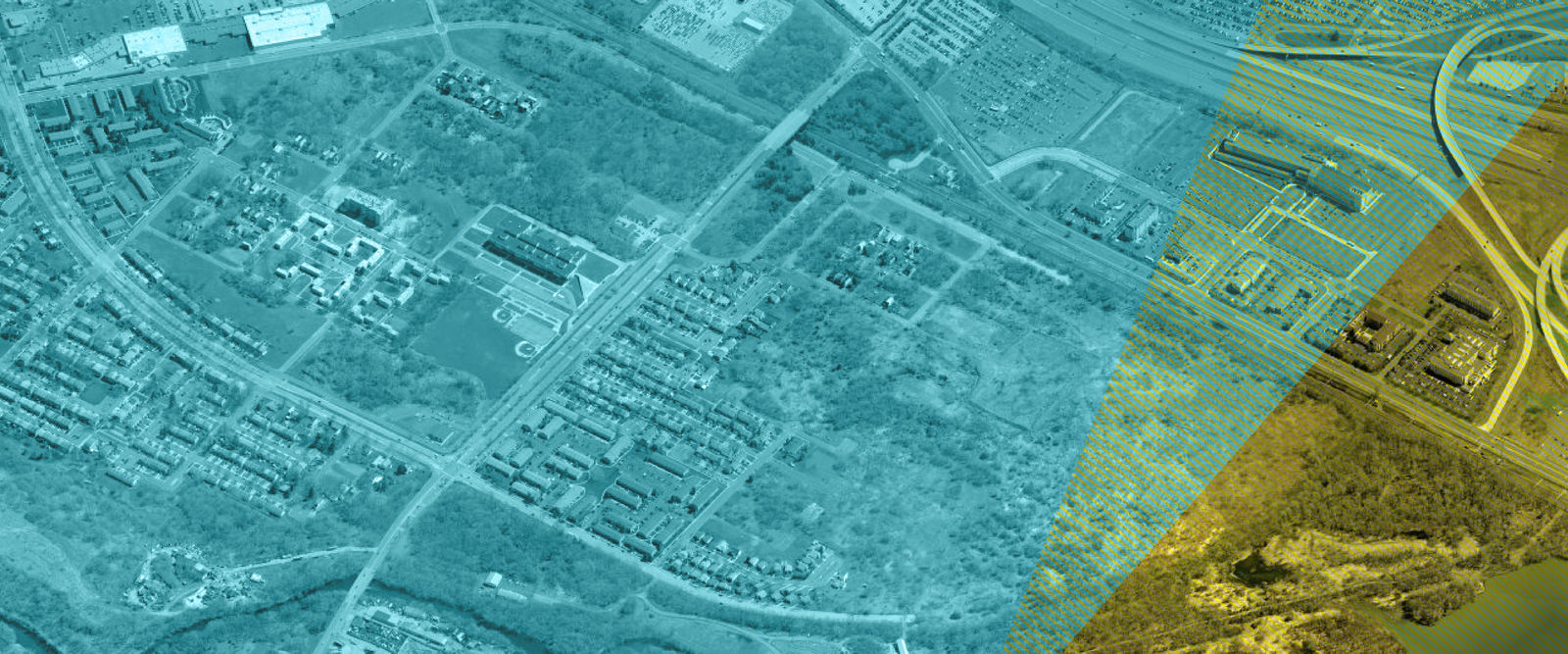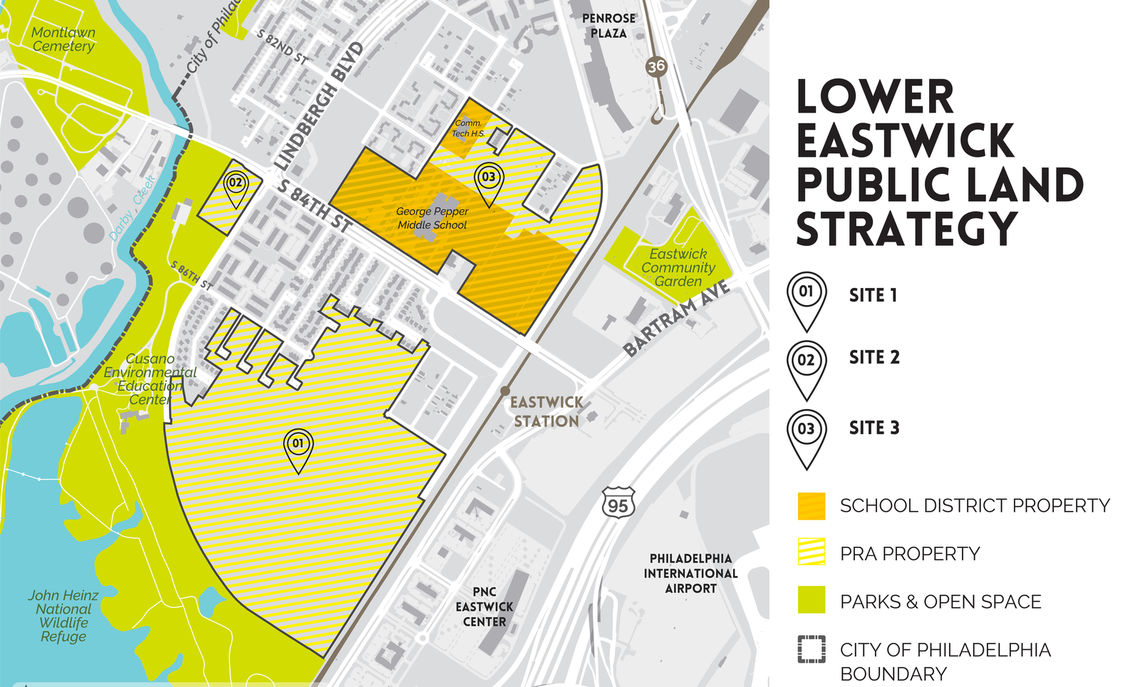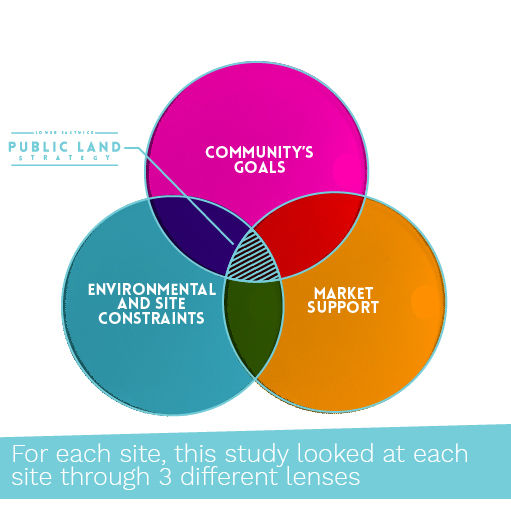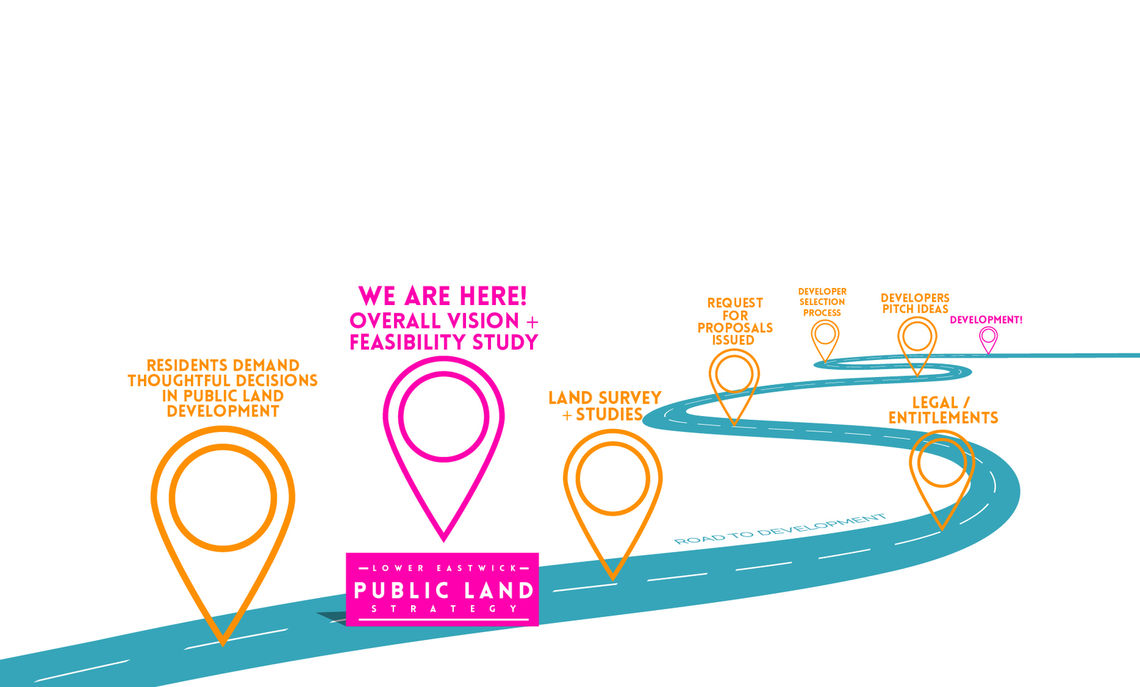LOWER EASTWICK PUBLIC LAND STRATEGY
Planning for an inclusive and resilient future in Eastwick
To date, this was one of our most challenging and rewarding projects we've had the pleasure of working on. In 1953, the City of Philadelphia's Redevelopment Authority released a preliminary redevelopment plan for a "new" Eastwick in the far southwest of the City of Philadelphia, a "City within a City" they called it, projected to house 45,000 people in new apartments, single family homes, and townhomes. At the time, it was one of the largest urban renewal projects in the country. To realize the plan, the Redevelopment Authority acquired almost 5,800 properties -- of which 2,500 had structures on them -- across 2,300 acres. After years of Eastwick residents protesting their displacement, the City finalized the plan in 1957 and used eminent domain to displace some 8,000 residents.
Multiple phases of the original redevelopment plan were implemented over several decades, including construction of two schools, 4,200 new housing units, and the Penrose Plaza Shopping Center. However, the full vision of the redevelopment plan was never realized, and approximately 128 acres remained vacant for decades.
With those unrealized plans came broken promises, deep rooted distrust, and trauma for the residents who remained in Eastwick. As one neighborhood leader told us,
"This city sold a bill of goods they never came through on. It led to many different issues that has not been rectified at all. Not one. And so it is my hope that the city will take a new, fresh look at what needs to be done, but never ignore how we got here in the first place."
While the City’s intentions of urban renewal may have been positive, the Eastwick project displaced thousands of people from their homes and disrupted an established, diverse community. The vision of a “City within a City” was never fully realized, and the scars that it left behind are still visible today.
“I’m still hurt. I’m still hurt from what the redevelopment took my family through and how they disrupted my life. How they made my father have a heart attack because he was wondering how am I going to take care of my family? Or made my mother depressed for life after moving because we were forced to move in a house that’s too small. You know, we had a house that was three times the size and we were forced to move in this house.”
The next chapter for Eastwick:
This feasibility study considered the potential uses and disposition of 3 large tracts of publicly owned vacant land totalling 185 acres in Eastwick, Philadelphia. Eastwick is located in Southwest Philadelphia, across I-95 from the Philadelphia International Airport, and just North of the John Heinz National Wildlife Refuge.
(Site 1) A 124.5-acre site roughly bounded by 84th Street, Lindbergh Boulevard, and Mario Lanza Boulevard, this parcel was formerly referred to as ‘Parcel A’;
(Site 2) A 4.5-acre site¹ at the southwest corner of 84th Street and Lindbergh Boulevard; and
(Site 3) A 58.6 acre site that includes multiple parcels, which for the purposes of this study were simplified into one ‘site’ including the former Communications Technology High School (George Wolf School), owned by the School District of Philadelphia, the former Pepper Middle School site owned by the Philadelphia School District, and additional PRA-owned lands located along and generally bounded by Mario Lanza Boulevard, between 81st & 84th Streets.
Our task was to develop a new vision for Eastwick, and answer 3 questions:
1. What are the community's goals?
2. What can the market support?
3. What are the site constraints?
We worked with experts from around the country, including Dr. Mindy Fullilove and the University of Orange, Beth Beckett of Real Estate Strategies, and Scott Bishop of Bishop Land Design, to help us answer these questions.
1. What are the community’s goals?
A robust public process reached 360 people, and included a neighborhood tour, two meetings with community leadership, three focused roundtable discussions, three large public meetings, and interviews with 42 individual stakeholders. Quickly in this process, it became clear that many residents are still harbouring resentment and distrust towards the City for their use of eminent domain during the Urban Renewal Plan, and never fully realizing that plan. In discussions about the future of the sites, residents lamented on the neighborhood not having enough resources, and would like to see some of the land put back to productive use. Above all, however, conversations about the future of Eastwick inevitably landed on flood risk and concerns about development exacerbating flooding in the neighborhood.
2. What are the environmental and site constraints?
Each of the sites presents different opportunities and challenges when it comes to its suitability for new construction and its role in environmental stewardship. Their location at the base of 2 local watersheds makes them threatened by large flood events, and much of the area is within FEMA's Special Flood Hazard Area. The existing soils and vegetation are a legacy of the Urban Renewal Plan and are likely of poor quality, and potentially contaminated, and it is one of the few areas in the City to potentially be impacted by sea level rise. In addition, the sites' proximity the Philadelphia International Airport provide additional constraints on the properties. Despite these challenges, it is this study's findings, with the data we have today, that while costly and difficult, it is possible to do limited development on these sites. Additional studies are recommended to confirm these findings, and ensure that new development would not make any of the flooding issues in the neighborhood worse.
3. What can the market support?
The advisory firm Real Estate Strategies (RES) conducted a market study to identify realistic land uses that current market conditions can support at each of the sites. They found that the market could support townhouse or twin homeownership uses, professional services/medical offices, market rate garden apartments, affordable senior apartments, a hotel, warehouse/distribution and light manufacturing uses. They did not find support for a more significant retail development given its proximity to Penrose Plaza.
In considering the market analysis, environmental analysis, and the community’s’ desire for both more resources and alleviating environmental concerns, is it possible to do responsible development in Eastwick? The short answer is, yes, it may be feasible to build in some areas and accomplish the following:
Adhere to a baseline: New development should not make any of the flooding issues worse.
Preserve the opportunity to study flood mitigation in low lying areas.
Utilize development to improve existing conditions where it’s appropriate and possible.
The Vision: A Village in the City
Eastwick has the soul of a village. People love its proximity to nature and its quiet, pastoral setting. But Eastwick lacks the organization of a village -- it has no Main Street, with a set of inviting shops that serve as a gathering places and crossroads. Becoming a real village involves enhancing both of those parts: enhancing the connection to nature and developing a Main Street that brings together civic, commercial, and cultural life. Becoming a “Village in the City” involves strengthening connections to citywide processes, services and organizations. Finally, becoming a “Village in the City” means solving the numerous disconnections -- within the neighborhood and between the neighborhood and the rest of the city -- that would make Eastwick easy to navigate, hospitable and charming.
Next Steps
-
This study should be viewed as a research document, written to ensure that, moving forward, the City -- with the community -- can make thoughtful and informed decisions regarding public land development, disposal, or preservation.
-
As an immediate next step it is necessary to conduct further studies, tests, and due diligence in order to confirm the development potential of these sites and their potential impact.
-
The effort to revitalize Eastwick - after so many decades of neglect and abuse -- will be long and difficult. It is essential that the neighborhood think of this effort as a long-term project. Residents should continue to remind themselves what they are FOR. While resident action can tend to focus on issues, a focus on alignment around shared values allows groups to work in coalition rather than competition. We can realize our vision if we are programmatic and constantly ask ourselves, “How do we move towards our goal?”
-





